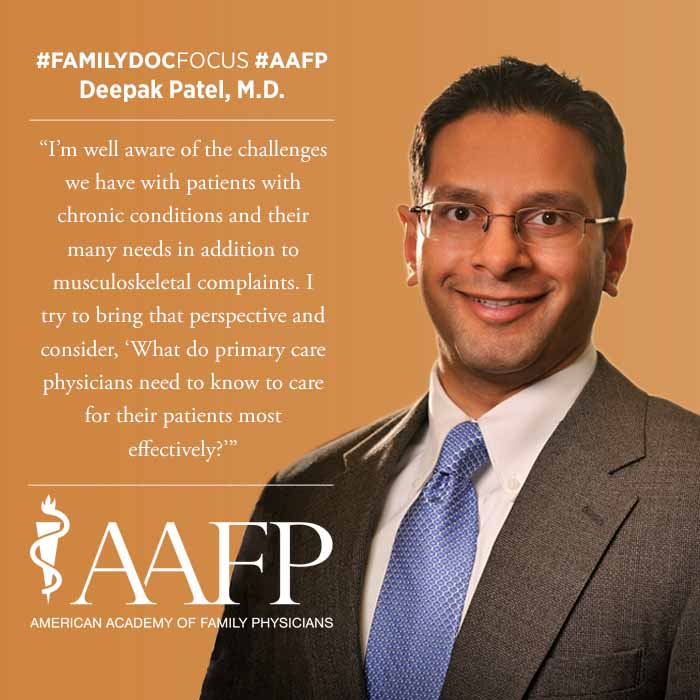Teenage Injuries Put FP on Sports Medicine Career Path
August 03, 2020, 03:32 pm David Mitchell – Deepak Patel, M.D., was a multi-sport athlete growing up in North Dakota, but medical opinions about his frequent injuries often put him at odds with the small town's general practitioner.

"My dad would tell me that I was going to have to sit out four to six weeks, and I was always discouraged, dismayed and probably a little bit belligerent," he said. "I would dig into his medical books and journals and try to find different treatment options. Then I would go back to him and say, 'I just need to do this and this, and then I can play.' It was really frustrating to sit out, and that really motivated me to do that early learning."
Patel's high school playing days ended before websites like familydoctor.org and Google existed, so his attempts at self-diagnosis and treatment required some work.
"I couldn't just search for an answer," he said. "I had to read about it. While I was doing that, I got interested in the other pathologies those books and journals were describing."
Thus, Patel followed his father into medicine and primary care. During his family medicine residency at the University of Illinois-Rockford, he sought out additional learning opportunities that combined his passions for health care and sports, including working with the team physicians for local minor league hockey and basketball teams. He then completed a sports medicine fellowship at the University of Michigan that included team coverage for athletic programs at Eastern Michigan University.
"I developed relationships with the athletes," he said. "They would seek me out, and sometimes it was not about injuries but some other primary care concerns. They got to know me and were comfortable with me. It was an opportunity to see how we can take care of college athletes at a high level."
Now Patel is passing on what he's learned as the director of sports medicine at the Rush-Copley Family Medicine Residency in Aurora, Ill., and as an assistant professor in the Department of Family Medicine at Rush Medical College.
"I had great mentors who exposed me to a lot of different learning opportunities and helped me gain hands-on experience," said Patel, who is a team physician for local high schools and provides football game coverage. "I try to give back to my community and with the residents, especially when they want to gain extra experience or team coverage with me."
Patel has published and presented the results of dozens of research projects -- with an emphasis on sports injuries and musculoskeletal topics -- and that level of expertise has led to a role as chair of the AAFP's Musculoskeletal and Sports Care Live Course.
Patel and chairs of 13 other AAFP Live Courses help select not only the CME content for their respective events but also which content from those events is presented again at the Family Medicine Experience. That process includes reviewing new evidence, and AAFP data generated from sources such as session evaluations and member feedback on topic preferences and priorities.
The Musculoskeletal and Sports Care Live Course offered about 22 hours of programming in three days. Patel, who expects about three-fourths of that Live Course content to be offered again during the virtual FMX in October, said it's vital for family physicians to be involved in planning and creating CME for a family medicine audience.
"I still practice primary care, so I'm well aware of the challenges we have with patients with chronic conditions and their many needs in addition to musculoskeletal complaints," he said. "I try to bring that perspective and consider, 'What do primary care physicians need to know to care for their patients most effectively?'"
Patel has been attending the AAFP's annual meeting since he was a medical student. Even before that, his family planned vacations around what was then called Scientific Assembly so his father could meet his own CME requirements.
"It's amazing to go from being a child of someone attending the conference to now getting to help select and present programming that family physicians are going to take home to their practices," he said. "It's been a wonderful experience to see all of the planning effort come together into valuable learning opportunities."